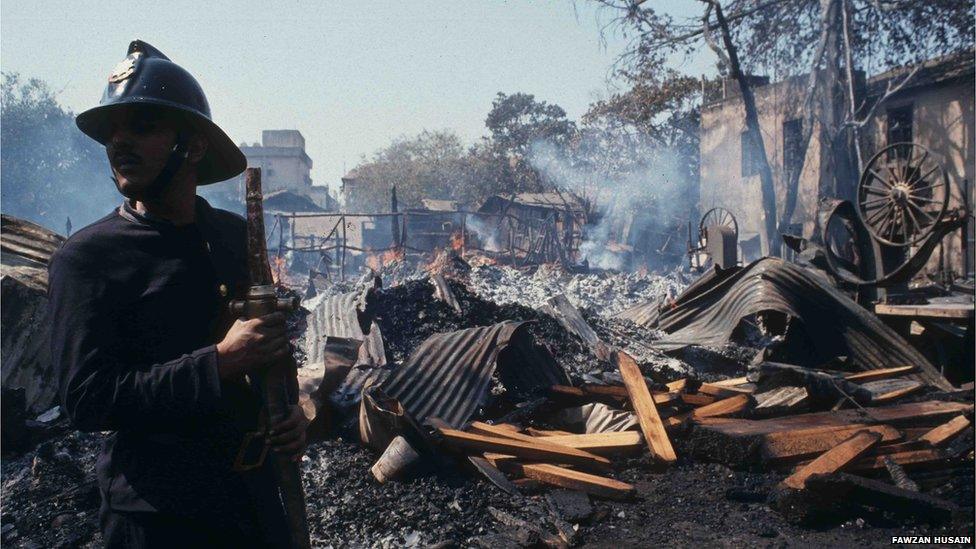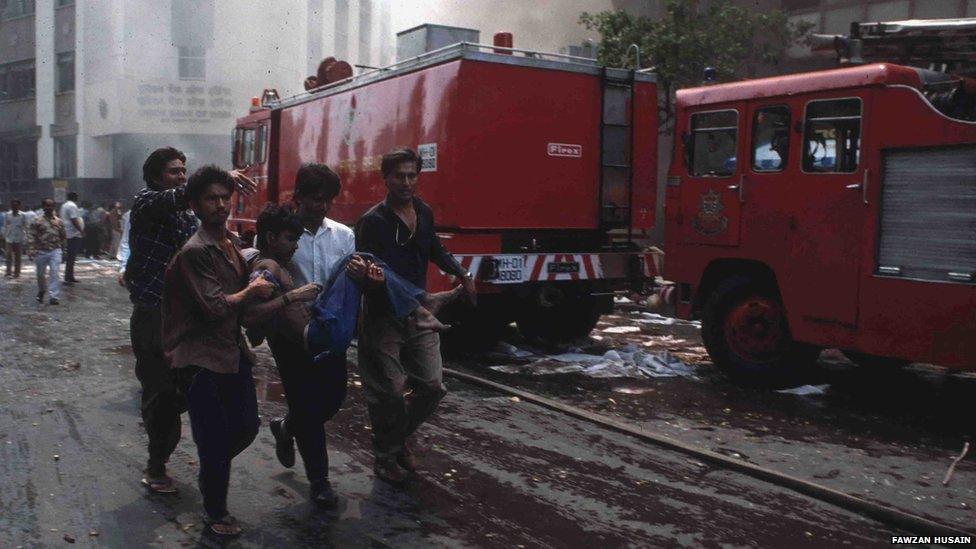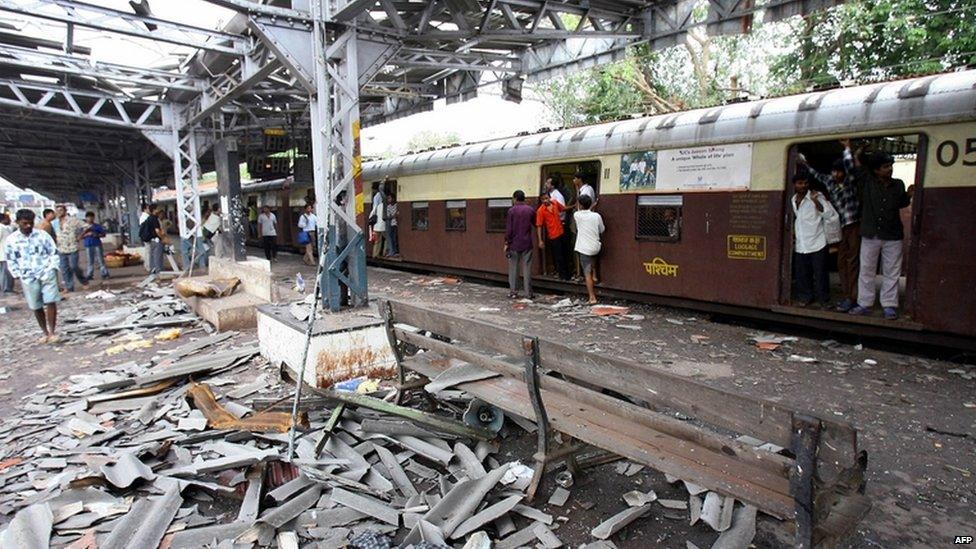How the 1993 blasts changed Mumbai forever
- Published

The serial blasts killed 257 people and wounded 1,400 people
India has executed Yakub Memon, the man convicted of financing the deadly 1993 Mumbai bombings. Columnist Bachi Karkaria reflects on how the bombings changed India's financial and entertainment capital forever.
Two hours and 10 minutes was all it took to knock the swagger out of Mumbai, then called Bombay.
Between 1.30 and 3.40 on that Friday afternoon of 12 March, 1993, the city detonated into a nightmare. It would wake up in bloodied disbelief, charred and chastened.
The 13 bombs which exploded in quick succession brought the city's most iconic buildings to their knees, beginning with the symbol of its financial supremacy, the Bombay Stock Exchange.
The explosions ripped through the Air India building in the south to the Sea Rock hotel at Land's End in the west, a strip of land that juts into the sea. The Plaza cinema owned by Bollywood legend V Shantaram, and the Century Bazar belonging to the Birlas - who along with the Tatas, were India's first business family - were left with gaping, smouldering holes.
The headquarters of the right-wing Hindu Shiv Sena party was an obvious target because the blasts were revenge for the religious riots of December 1992 and January 1993, external, in which a large number of Muslims were killed.
Massive blow
The riots, in turn, had been triggered by the demolition of the Babri mosque by Hindu extremists , externalin the holy town of Ayodhya in December 1992. The riots had already led to a recalibration of Mumbai's sense of itself.
Communalism is anathema to commerce, which has historically been Bombay's presiding deity. So the fires had died down, thanks to the city's intrepid peace committees - and the mundane fact that Hindu businesses couldn't survive without their Muslim workers or suppliers.
The 1993 blasts left 257 people dead, injured 1,400 and delivered a massive blow to Mumbai's psyche. The bombings were also metropolitan India's first exposure to terror.
For decades, the Mumbai noir had been dominated by gold smuggling, with its ancillary industry of crime and gang warfare.
Smugglers were perversely romantic figures, none more so than Dawood Ibrahim, external, the son of a constable who had become the city's most powerful underworld figure, and eventually became India's most-wanted man.
Ibrahim, along with Tiger Memon, was widely seen as having masterminded the attacks and they escaped.
Now for the first time his gang had leapt beyond the violent protection of its commercial interests, and into a political vendetta wreaked indiscriminately against an entire city.
Indeed, terrorism has struck Mumbai most often - a city that also seems to be the least wired for it.
In 2003, the city froze in terrified deja-vu, as blasts humbled two other icons, the Gateway of India and the jewellery hub of Zaveri Bazar. , external
In 2006, serial blasts tore through its busy suburban train network, external during peak hour rush, killing more than 180 people.

The March 1993 blasts targeted a dozen sites, including the Bombay Stock Exchange, the offices of national carrier Air India and a luxury hotel

More than 180 people were killed by seven bombs on Mumbai's train network in 2006

Attacks on the railway station, luxury hotels and a Jewish cultural centre in Mumbai claimed 166 lives in 2008
Then, in November 2008, there was a 60-hour siege of the city in what turned out to be the biggest terror strike in India, external. Attacks on the railway station, luxury hotels and a Jewish cultural centre claimed 166 lives. Nine gunmen were also killed.
It drew Mumbai and India into global terror, and was the true successor to the 1993 bombings, in terms of trauma.
There would also be three near-simultaneous explosions in July 2011, in congested trader hubs, killing 26 people.
'Spirit of Mumbai'
But from the ashes of the 1993 bombings rose a phoenix: the "spirit of Mumbai".
Ordinary people rushed to the rescue and ferried the wounded to hospitals in flagged-down cabs and cars. By the end of the day, blood banks were full with voluntary donations.
The next morning, people were back at work in offices left intact in the devastated buildings. No one stood around waiting for official instructions or interventions. It was awe-inspiring, and it was unique.
This "spirit of Mumbai" would manifest itself over and over again.
In 2006, those living in the slums adjacent to the railway tracks raced to the scene and carried the bleeding victims in what was perhaps their only bed sheet. The tales of heroism swelled in 2005 when the city went under a deluge, external for three days.

Mumbai is one of India's most cosmopolitan cities

'But the serial crises to which Mumbai has so relentlessly been subjected shows that this spirit is indeed its proudest possession'
This ability of Mumbai to rise above every crisis would come to be mocked as one assault followed another.
It would be dismissed as nothing more than the response of beleaguered citizens who had no choice but to pick up the pieces and get back to their lives.
It would be seen as an excuse for official apathy: leave citizens to do what should be the responsibility of government or city administration.
But the serial crises to which Mumbai has so relentlessly been subjected shows that this "spirit" is indeed its proudest possession, as much the raison d'etre of its singular triumphs as of its undeserved catastrophes.
Undeniably, it has undeniably also served as a beacon for all the other citizens living under India's widening shadow of urban terror.
Bachi Karkaria is a Mumbai-based writer and journalist